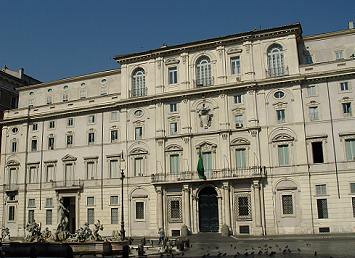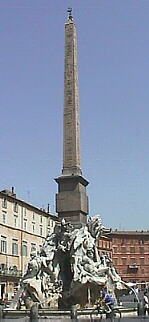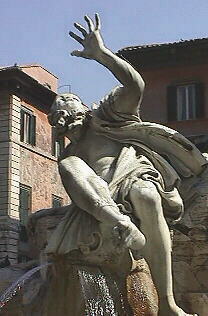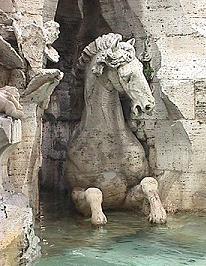In 1574 one of the new branches of the Aqua Virgo reached the former site of
emperor Domitian's stadium. An open space during the Middle Ages,
in Renaissance Rome it had gradually turned into a square,
yet maintaining the original long and oval shape, when buildings had risen
all around its perimeter. Once officially called piazza in Agone,
by the 16th century this name had already been corrupted by the people into
the more familiar piazza Navona.
THE SIDE FOUNTAINS
According to the cardinals' document, two fountains were
to be built here, at both ends of the oval.
Since the water duct crossed the center of the place, a third output, a simple
drinking-trough for horses, was added to the original project between
the two larger structures. |
|

piazza Navona (early 1600s): the two fountains and the
central trough are clearly visible;
in the left half of the square
a pedlar or a charlatan is surrounded by a small crowd |
Della Porta was in charge for the two main fountains.
Following his design, two marble basins were carved, with a multilobed shape;
in the original version they rested above two steps. Then each of them was
encircled by a marble parapet, to prevent them from being damaged by the many
carriages that drove through the square.
Since the two basins still needed a decoration, della Porta thought of
recycling the
four large tritons that had
already been carved for piazza del Popolo (see page 2), but had been kept
aside. |
 |

the masks and tritons around the basin |
These ones were used for the fountain on the southern
end of the square: here the water gushed from a small group of rocks in the center
of the basin, and from the horns played by the four tritons. Small additional groups were carved
for each of the two fountains, in the shape of a grotesque mask between a
pair of small dolphins.
But when the time came to carve the remaining four large tritons (or similar figures)
for the northern fountain, there were no longer funds left. The same four masks that
should have adorned its bare basin were reused for the making of another fountain
that della Porta was building, the one in front of the Pantheon.
|
This arrangement remained steady for almost one century.
When in 1651 the
square's central trough was replaced by Bernini's famous Fountain of the Rivers
(see the second part of this page), with the remaining funds also the southern
fountain was enlarged.
Why the money was spent on this one, and not on the
northern one, still unfinished, may be easily understood considering that on the
southern side of the square, facing the fountain, stands Palazzo Pamphilj, and who
had ordered the works was the same owner of the mansion, pope Innocent X, i.e. Giovanni
Battista Pamphilj.
Bernini, in charge of this work too, replaced the rocks with a group consisting
of three dolphins topped by a large murex shell, that the people of Rome
immediately nicknamed "the Snail". |

the fountain and Palazzo Pamphilj |
Innocent X was not very happy with the
rather small size of this group, and only one year later he got rid of it by
giving it as a present to his sister-in-law, the famous (and infamous) Dame Olimpia.
Bernini was then asked to create something larger.

the final arrangement of the Fountain of the Moor,
including the ground basin added by Bernini |
Following a further unsuccessful project, the versatile artist finally satisfied
the pope by drawing a naked bearded figure balancing on a shell, in the attitude of grasping a dolphin
by the tail, while the latter, between the man's legs, spouts water from its mouth.
Due to their proportions, either the man is a giant, or the dolphin is a midget!
The facial expression of the figure, vaguely reminiscent of an African
(although this was not Bernini's purpose), caused the figure to be referred to as
"the Moor", whence the name Fountain of the Moor, still officially used. |
Instead the other fountain, at the northern end of the square, without any
particular group nor decoration, used to be called
Fountain of the Coppersmiths, after the nearby shops that sold cauldrons, pans
and other metal kitchenware.
In drawing the moor's figure - at least its upper part - Bernini
may have likely been inspired by the popular "talking statue" of Pasquino (see
Rome's
Talking Statues), which stands only 50 metres or yards off this spot,
as a comparison of the two figures clearly suggests.
This is strange, because due to its very poor condition no
artist would have thought of Pasquino as a model.
Furthermore, in those days the "talking statues" represented the
worst enemies of the pope-king (who in this case was Bernini's client), and the old
torso without limbs took the blame for most of the satirical posters against the ruling
class, often hung to its neck at night-time.
But Bernini was known to be a man of humour, and his choice may have not
been a mere coincidence, maybe a revenge for how Innocent X had treated
him earlier. |
 |

the Moor (left) and
the nearby Pasquino |
Having further funds for piazza Navona's works been obtained,
Bernini removed both the steps and the parapet from
the southern and the northern fountains, and built for the southern one alone
a larger basin at ground level, or pool, that completely surrounded the
original structure, repeating its shape, and certainly improving its look.
Meanwhile, at the northern end of the square, the more neglected Fountain
of the Coppersmiths still remained without tritons, without masks,
and most of all without a central group.
The following pope Alexander VII had a ground basin made for it, like the one at the southern end.
But to be finished, the northern fountain had to wait for the fall of the papal rule.

the Fountain of Neptune, and (right) a detail
of its 19th century groups |
 |
In 1873, no longer the pope's whims, but a public competition held by Rome's municipality
chose the central group by Antonio della Bitta, featuring Neptune in
the attitude of piercing a large octopus with his trident, surrounded by smaller
ones featuring horses, putti and naiads, in alternate order, by Gregorio Zappalą.
Obviously, its name changed into Fountain of Neptune.

Bernini's "Snail" (copy) |
The reader may now wonder what happened to the "Snail".
The latter was actually used for another fountain, a late work by
Alessandro Algardi (c.1600-54), located in the heart of Villa Pamphilj,
once private gardens of the noble family, and now a public park.
In recent times, the original group was replaced by a copy, and stored in the
Doria Pamphilj Gallery.
And the old drinking-trough?
At first, it was moved to the northern end of the
square, and simply left beside the Fountain of the Coppermakers,
until the latter was completed. It was then taken to Villa Borghese, near the small
lake, where it can be seen today.
But by the time this happened, piazza Navona's southern fountain was to suffer
a rather disgraceful alteration. |
Since the tritons and the mask groups carved by della Porta already showed heavy
signs of their age, instead of being restored, these ones too were moved to
Villa Borghese; in piazza Navona they were replaced by copies,
made by the obscure artist Luigi Amici, while the originals, exposed
to bad weather and occasional vandals, kept worsening more and more. At last,
only a few years ago, the tritons were removed, to be restored. The
trough and one of the mask groups are still there.

Villa Borghese: (left) the old trough and (right) one of
della Porta's original masks, over a sarcophagus trough |
 |
THE FOUNTAIN OF THE RIVERS
Approaching year 1650, a Jubilee year, pope Innocent X had in mind to build
a third fountain in piazza Navona, where his family mansion stood, by replacing
the central drinking-trough with something more grand.

the Fountain of the Rivers |
Under the previous pope Urban VIII (Barberini), the official fountain-maker had been the famous architect Gianlorenzo Bernini. The Barberini and the Pamphilj
families, though, were enemies, up to the point that after Urban VIII's death
and the election of Innocent X, some members of the Barberini family
were actually persecuted and had to flee Rome. |
This explains why Innocent X did not choose to be the patron of Bernini (who had created many splendid works for his enemies), but of another famous architect: Francesco Borromini.
For the central fountain of piazza Navona, the pope held a contest, asking a
number of architects (but not Bernini) to submit their projects.
Borromini could have easily won, if only his creation
had been less simple than what he actually drew: an obelisk, whose base was
surrounded by four sea-shells that spouted water. In fact, Borromini was not
a fountain-maker, and his name is not remembered for any of Rome's fountains.
Bernini, neglected by pope Innocent, had been
asked to build a new duct in order to draw water from the Aqua Virgo's
main output (i.e. the present Trevi Fountain), and carry it straight into
piazza Navona: the old branch did not allow a sufficient flow for a third large
fountain.
On this occasion Bernini resorted to his Neapolitan cunningness.
Innocent X's sister-in-law, Dame Olimpia Maidalchini (simply Pimpa, or
Pimpaccia for the roman people, who hated her), was a very greedy woman;
especially atfer the death of her husband, the pope's brother, she was known
to exert a strong influence upon Innocent's decisions. Bernini, yet not taking part to
the contest, drew a beautiful project all the same, and made
a silver model of it, which he then presented to Dame Olimpia, making her eyes
sparkle. |

the crest of the Pamphilj family |
Pope Innocent, who meanwhile had rejected all the projects by the other architects,
was certainly convinced by his sister-in-law to choose Bernini's fountain.
The irascible Borromini went literally mad when the pope
abruptly dismissed him, in favour of his rival! The legends about the friction
between these two architects (see
Bernini vs. Borromini)
were born following this fact.

the Egyptian-like obelisk
rests over the fountain |
But the expenses for the new fountain were so high
that to satisfy her sister-in-law Innocent X had to tax the bread, so
the people had one more reason for hating Pimpaccia.
What Bernini conceived for piazza Navona is undoubtly the most complex and ingenious
composition among Rome's fountains. He knew that the pope would have
liked an obelisk to overlook the fountain, particularly the ancient roman one that had been
recently unearthed by the Circus of Maxentius (a copy of
the famous Egyptian spires, see also Obelisks,
part II). Bernini made the obelisk look much
taller by standing it over a group of rocks, that form a cavity below, in the shape of a cavern.
In those days this was an absolute innovation, as the classic architectural
schemes forbade the use of a hollow base for a heavy weight, such as that of an
obelisk. But Bernini proved this to be perfectly possible. Four huge allegories sit on the corners of the rocks; they represent the major river of each of the four continents known, according to 17th century
atlases: the Danube (carved by Antonio Raggi) for Europe, the Ganges (by Claude Poussin) for Asia, the Rio de la Plata (by Francesco Baratta) for America and the Nile (by Antonio Fancelli) for Africa. |
The latter allegory was carved with a veiled head,
referring to the unknown sources of this river, only discovered in the
19th century.

the veiled Nile |
On the northern and southern sides hang two beautiful Pamphilj crests, ideally
representing Innocent X's religious authority over the whole world.
The water springs from several holes in the rocks, once gold (they were
painted), and gathers in a large basin at ground level.
A variety of animals refer
to the four continents. |
|

the Rio de la Plata's dramatic attitude |
On the eastern side, a lion comes out of his den, i.e. the cave below the
rocks, to have a drink by a tall palm-tree, that climbs almost to the base of the obelisk.
On the opposite side a horse exits the cavern raising his front legs in a gallop, while
a snake crawls atop of the rocks, with a fearsome open mouth.
Below the Rio de la Plata, an alligator peeps from a the northern side of the
fountain (its shape is amusing, since Bernini and his assistants may have never seen a real one),
while on the western side a group of cacti grows on the rocks.

the horse, leaving the cave |
A large fish and a water serpent swim in the
ground basin; actually, they swallow the water, a fancy
drainage device.
Not only Innocent X appreciated Bernini's masterwork, but the whole city
of Rome did (except Borromini!): the awing composition left everybody
stunned when the fountain was finally unveiled, on June 12, 1661. |

the curious alligator |
A faithful description in verse of piazza Navona's fountains
is found in the famous epic poem Meo Patacca, written in roman dialect,
first published in 1695 (see Meo Patacca,
Canto III).
Further pictures of the Fountain of the Rivers can be found in
Meo Patacca's Setting.


the snake above the rocks, and the water-swallowing fish
other pages in part III
1 | 2 | 3 | 4 | 5 | 6 | 7 | 8 | 9 | 10 | 11 | 12 | 13 | 12 | 13 | 14 | 15 | 16 | 17 | 18 | 19 | 20 | 21
